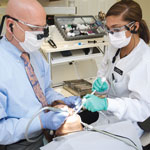
Dancing can be defined as “to leap or skip about excitedly,” or, “to take a series of rhythmical steps and movements.” In many ways the second definition relates to dentistry as well. Both activities require dedication, constant practice, and the ability to quickly read and adapt to a situation.
When done properly, dancing and dentistry transcend technique and become art. When done poorly, they quickly degenerate into chaos. In dentistry, if a procedure does not go as planned, a feeling of panic typically ensues. The mark of a good partnership, be it dance partners or dentist and assistant, is the ability to recover from the unexpected without missing a step and without the patient noticing.
For large-case dentistry to become a big part of your practice, you and your assistant must develop a choreography that makes communication and collaboration second nature. Although cases and patients will vary, the basic steps should not.
As the dentist, you are the lead, and you are responsible for setting the timing and tempo of each movement. This ensures seamless coordination between you and your assistant. Without a strong lead, the procedure will unravel into a series of missteps that will leave all participants disappointed.
To be the most effective dentist, first establish a means of communication unseen by the patient but precise enough that the assistant can act decisively. When my assistant and I start to refine our margins on teeth surrounded by gingival tissue, for example, hemorrhaging will likely occur.
Rather than alerting the patient to what he or she may consider a gusher of BP proportions, we handle the whole situation by uttering a simple word: stasis. This initiates a choreographed series of steps that address a routine inconvenience without any perceived drama.
Let me emphasize, you must have practiced these steps with your assistant prior to expecting this level of efficiency. If you are consistent in using this approach, your assistant will quickly recognize when and what is needed. Soon, not even a word will need to be spoken. What once required direction now becomes the fluid movement of two highly skilled professionals working as one.
Besides verbal communication, visual cues and prompts are also helpful. In my office, a nod can speak volumes to an attentive assistant. That simple signal can mean I need the tooth of interest to be rinsed and dried, and I need my mirror to be dried. A tap on the cotton roll will tell her that it’s time for replacement.
Again, while teaching and practicing simple gestures within the context of procedures is simple stuff, it must be done in advance. Expecting an assistant to intuit what you want without having rehearsed the steps will devolve into an exercise in frustration.
A verbal game-plan review before you “dance” in dentistry will keep you from stepping on each other’s toes. After the procedure, an open and honest critique of both your performances will ensure continual improvement. No matter how well the procedure went, every great team will find at least one area to improve next time.
Doing complex, life-changing dentistry can be intimidating to even the most seasoned dentist. When I decided to make full mouth reconstruction a regular part of my practice, I attended a Full Arch Reconstruction seminar taught by Dr. Jim Downs.
While at the seminar, I witnessed the power of “clinical synchrony,” which is the ability of doctor and assistant to work as one. As I watched Dr. Downs and his assistant do a full arch in a few hours, I realized that doing the procedure was less a question of skill than it was of effective teamwork.
While initially contemplating full-arch reconstruction, much of my stress came from the misconception that I had to do and control everything myself. Since then I have come to believe a well-choreographed “dance” practiced often before a procedure can help dentists handle complicated cases faster and with less stress than thought possible.
Just as an accomplished dancer must master multiple styles of dance, you and your assistant must be able to accommodate the needs of different patients. I’m talking primarily about how the procedure is presented. For example, by nature I am witty and light-hearted, and for most of my patients, that is a great fit. My assistant is a great complement to my personality. We click—like a dental version of Fred Astaire and Ginger Rogers. If you don’t have your Ginger, you need to find her quick.
That said, not all patients appreciate the jazzy approach. Never fear. Fred and Ginger can waltz, fox-trot, tap, tango, swing or whatever we need to do to please our patient. We’re not being fake or insincere—we’re just picking up on our patients’ unique tastes and acting accordingly. The ability to change up “steps” has come only after we have mastered the basics.
Up to this point, my discussion has centered on three people. But this dance goes way beyond the dentist, assistant, and patient. In reality, another important team exists outside the operatory. To achieve true greatness, the dentist or dancer needs an expert instructor or mentor. Nobody can achieve greatness alone.
The Dick Barnes group has been my template for success. While I used to have two left feet, with the group’s help, my team and I can seriously cut a rug. Arrowhead Dental Laboratory has also been a key player. Without their artistic input, our dancing would not have the polish that our patients have come to expect. Judging from the number of people who want to dance with our team, I would say that we have developed some great moves.
Do’s and Dont’s for Dental Success
Do:
- Always have a wax-up, a reduction guide, and provisionals done for every large case. This is in addition to a full-mouth series of radiographs and intraoral and extraoral photographs. You need them to communicate well with all parties . . . don’t get on the dance floor without them.
- Be bold but wise. Don’t overreach, but always expand your comfort zone. Seek wise counsel to help with questions during case preparation. This is where mentors like the Dr. Dick Barnes Group come in.
- Tell your assistant in great detail about any “steps” that could change during a procedure, such as a possible endodontic shuffle.
- Remember that you have a person in the chair. It’s too easy to develop tunnel vision during intense and lengthy procedures.
- Evaluate your performance and your partner’s openly and honestly. Compliment each other while also offering positive criticism. There’s no room for egos with a patient’s smile on the line.
Don’t:
- Leave your partner out of the continuing education courses that you take. It’s hard for someone to perform competently in a dance they’ve never seen.
- Underestimate appointment time at first. Patients always appreciate the extra level of service, and it will cut your stress level in half.
- Ever let the patient see or perceive any stumbles. They should already think you are Fred and Ginger. Don’t turn into Jerry Lewis.
- Undersell your patients with less than first-class treatment. With top-rate training, you can and will deliver a performance that will leave you, your partner, and your patients breathless and looking forward to the next dance
Related Articles: The Dance – An Assistant’s Perspective









